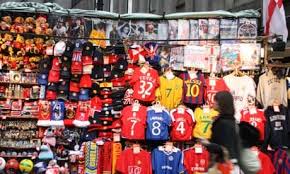
Why Combatting Fake Football Shirts Isn’t Working
Share
Football has become increasingly expensive, and while I don’t judge those who buy fake football shirts, today I want to shed light on the real issues behind the counterfeit football shirt industry and why current efforts to stop it are falling short.
The Widespread Problem of Fake Football Shirts
A quick Google search for “buy football shirts” will reveal a shocking number of websites offering counterfeit jerseys. These are not isolated listings or one-off sales; they’re sophisticated operations, with websites designed to look as professional as any official store. For example, SoccerLord.se sells everything from retro shirts to the latest releases, shipping them across Europe, the U.S., and beyond.
I currently monitor 22 counterfeit sites myself, and I know there are many more. This issue isn’t just about one or two sites slipping through the cracks—it’s a large, global market. Let’s look at why this matters and why it’s more than just a victimless crime.
The Impact of Counterfeit Football Shirts on the Football Community
For those who wonder, “Why does it matter if someone buys a fake shirt?” here’s a breakdown of the key issues:
-
Lost Revenue for Clubs of All Sizes
Counterfeit sales impact clubs financially, and it’s not just big clubs that feel it. Smaller teams featured on these sites rely heavily on merchandise revenue. Every fake shirt sale diverts funds that could support player development, fan engagement, and essential club operations. -
Potential Safety Concerns for Fans
Authentic kits go through safety checks, especially children’s jerseys. Fake shirts skip this step entirely. We don’t know what materials are used, if they’re treated with toxic dyes, or if they meet basic safety standards. Parents buying counterfeit kits may unknowingly expose their children to harmful materials. -
Ethical Concerns Around Labor
Counterfeit jerseys are often made in unregulated environments, possibly with child labor or forced labor. Without oversight, there’s no guarantee that these products are produced ethically, raising serious questions about worker safety and rights. -
Links to Organized Crime
The counterfeit industry is frequently associated with organized crime networks. Money from counterfeit shirt sales may be funding illicit activities. While one sale might seem harmless, collectively, this black-market revenue often funnels into serious criminal enterprises.
Why Efforts to Combat Fake Football Shirts Aren't Working
When it comes to enforcement, the lines of responsibility are unclear, and efforts often stall. Here’s how the system breaks down:
-
Premier League and EFL: While one might expect league bodies to protect clubs, they instead defer responsibility, claiming it's up to individual clubs to handle counterfeit sales.
-
Football Clubs: Only a few clubs outsource brand protection to specialized companies, but most don’t respond to inquiries. This lack of response makes it difficult to tell if clubs are even aware of the scale of the counterfeit market affecting them.
-
Sports Brands: Six months after reaching out to brands like Nike and Puma, I still haven’t received a reply. Brands have the resources to tackle this problem but appear uninterested or overwhelmed.
-
Brand Protection Agencies: I spoke with a major brand protection company, and they admitted they couldn’t take down sites like SoccerLord.se due to jurisdictional issues. Some websites operate in countries with minimal enforcement, making international crackdowns challenging.
-
Law Enforcement Agencies: Local police suggest contacting trading standards, but these agencies are often under-resourced and overwhelmed. Action Fraud and the National Crime Agency (NCA) face their own backlogs and prioritize larger criminal cases over counterfeits, leaving counterfeit football shirt cases low on their list.
Why Fake Football Shirts Are Here to Stay – For Now
The counterfeit football shirt market shows no signs of slowing down. In the UK alone, fake football shirt sales amount to millions of pounds each year, and globally, the numbers are staggering. This trend is growing, not declining, as clubs, brands, and law enforcement struggle to take action.
Without effective deterrents, counterfeit sellers are emboldened to expand their operations. This only further harms clubs, endangers consumers, and potentially supports criminal organizations.
The Way Forward: Steps to Address Counterfeit Football Shirt Sales
Addressing this issue requires collaboration across the board. Here are some suggested steps to tackle the counterfeit football shirt market effectively:
-
Increased Involvement from Clubs and Leagues: Clubs, leagues, and brands must work together to address counterfeit sales and recognize that this is a collective issue impacting all levels of the sport.
-
Government and Legal Support: Lawmakers could provide better tools for international cooperation in tackling counterfeit sales, especially in regions where legal enforcement is weak.
-
Brand Protection Firms with Greater Jurisdictional Reach: Brand protection agencies may need to develop partnerships or collaborate with local enforcement in countries where counterfeit sellers operate, to improve the enforcement process.
-
Consumer Education: Fans should be educated about the risks and impacts of buying counterfeit jerseys. Making the potential risks more visible might encourage fans to buy authentic gear when possible.
Conclusion: Counterfeit Football Shirts Are a Growing Threat
For fans, this might seem like a minor issue, but counterfeit football shirts pose a real threat to clubs, brands, and the sport as a whole. Protecting the integrity of football requires stakeholders to step up, collaborate, and push for solutions to an issue that continues to grow unchecked.
If you’re passionate about football, consider the impact of counterfeits on the game. Tackling this issue can help clubs, support ethical production, and ensure that the game we love remains protected for generations to come.
